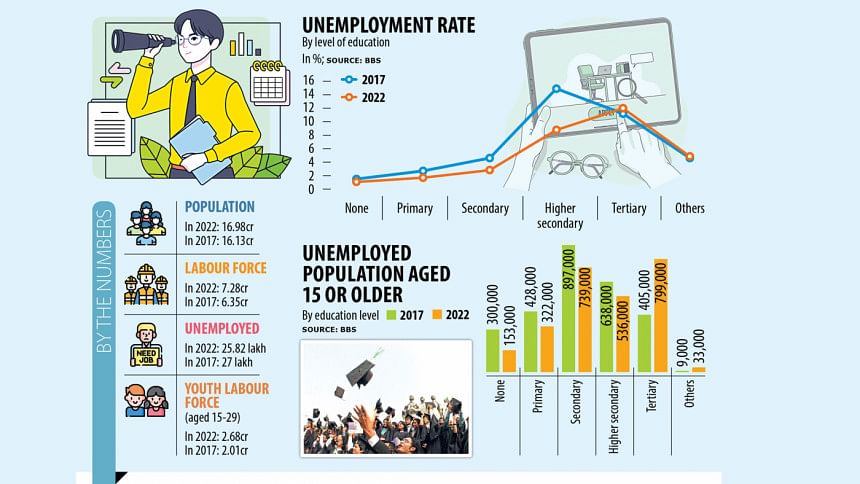Unemployed graduates double to 8 lakh in 5yrs

Almost every weekend, residents in Dhaka see a common scene in front of educational institutions: youths are either waiting at the gates to go inside or coming out after taking part in the recruitment tests in their efforts to land jobs.
Masudur Rahman, who graduated from the National University four years ago, is one of them.
He has been sitting for recruitment tests quite frequently for the last several years in Dhaka by travelling about 130 kilometres from his village home in Sirajganj, a northwestern district.
"The job market is very competitive. Sometimes, I compete with as many as 1,500 candidates against a post," said Rahman.
The 27-year-old is one of the thousands of graduates in Bangladesh looking for jobs and also one of nearly 8 lakh graduates who are currently not in employment.
And the Labour Force Survey (LFS) 2022 released by the Bangladesh Bureau of Statistics (BBS) on Wednesday painted a grim picture that the number of unemployed graduates is rising.
The unemployment rate among persons with tertiary-level education rose to 12 percent in 2022 from 11.2 percent in 2016-17.
During the five years, the number of unemployed graduates doubled from around 4 lakh in FY17, raising the question of whether the education system generates enough qualified resources, BBS figures showed.
Rizwanul Islam, an economist and a former special adviser for the employment sector at the International Labour Office in Geneva, said the unemployment rate among the educated is found to be higher than the average rate in many developing countries.
"Bangladesh is no exception."
However, when compared with the FY17 data, the 2022 figure tells a different story.
In FY17, the unemployment rate was the highest among those with higher secondary and equivalent education. In 2022, the rate was the highest among those with tertiary-equivalent education.
He said: "This raises a question about the usefulness of higher education from the point of view of the labour market. Is the education system producing graduates whose qualifications are not of any use when it comes to getting jobs?"
Graduate unemployment also highlights the issue of justification for further investments in tertiary education.
"Should the country go for further investments in such education without giving attention to its usefulness and effectiveness?" Islam said.
The LFS 2022 showed that the overall labour force grew to 7.30 crore last year, an increase by 95 lakh in five years.
The number of unemployed persons declined to 25.8 lakh from 27 lakh during the period, driven by the reduction of joblessness among the people who received higher secondary, secondary and primary level education.
The unemployment rate among people with higher secondary qualification was 8.87 percent in 2022. It was 2.82 percent among those who completed secondary education.
The unemployment rate among the people with no education declined too.
Sayema Haque Bidisha, a professor of economics at the University of Dhaka, said there is a major gap in expectations between recruiters and candidates.
She pointed out that the academic system does not equip students with practical knowledge and skills. "So, recruiters don't get skilled employees."
On the other hand, a huge number of graduates could not enter the job market owing to a mismatch in expectations, she added.
Prof Bidisha also sees a lack of quality in the primary education system.
"This gap remains within the students and not all of them can overcome this."
The economist does not support the idea of enrolling all students who passed higher secondary in the undergraduate and graduate programmes.
She pointed to the social stigma related to technical and vocational education.
"The number of unemployed graduates will not drop if students don't want to move to technical education."
Binayak Sen, director-general of the Bangladesh Institute of Development Studies, says the rise in unemployed people at the tertiary level was not unexpected.
Due to Covid-19 and the Russia-Ukraine war, the unemployment rate at the tertiary level might have increased, he said.
The survey also paints positive images as well.
For example, the female unemployment rate in rural areas fell drastically from 26.1 percent in FY17 to 18.66 percent in 2022.
"It indicates that rural women have participated in the workforce thanks to the presence of NGOs and other organisations," Sen added.

 For all latest news, follow The Daily Star's Google News channel.
For all latest news, follow The Daily Star's Google News channel. 








Comments